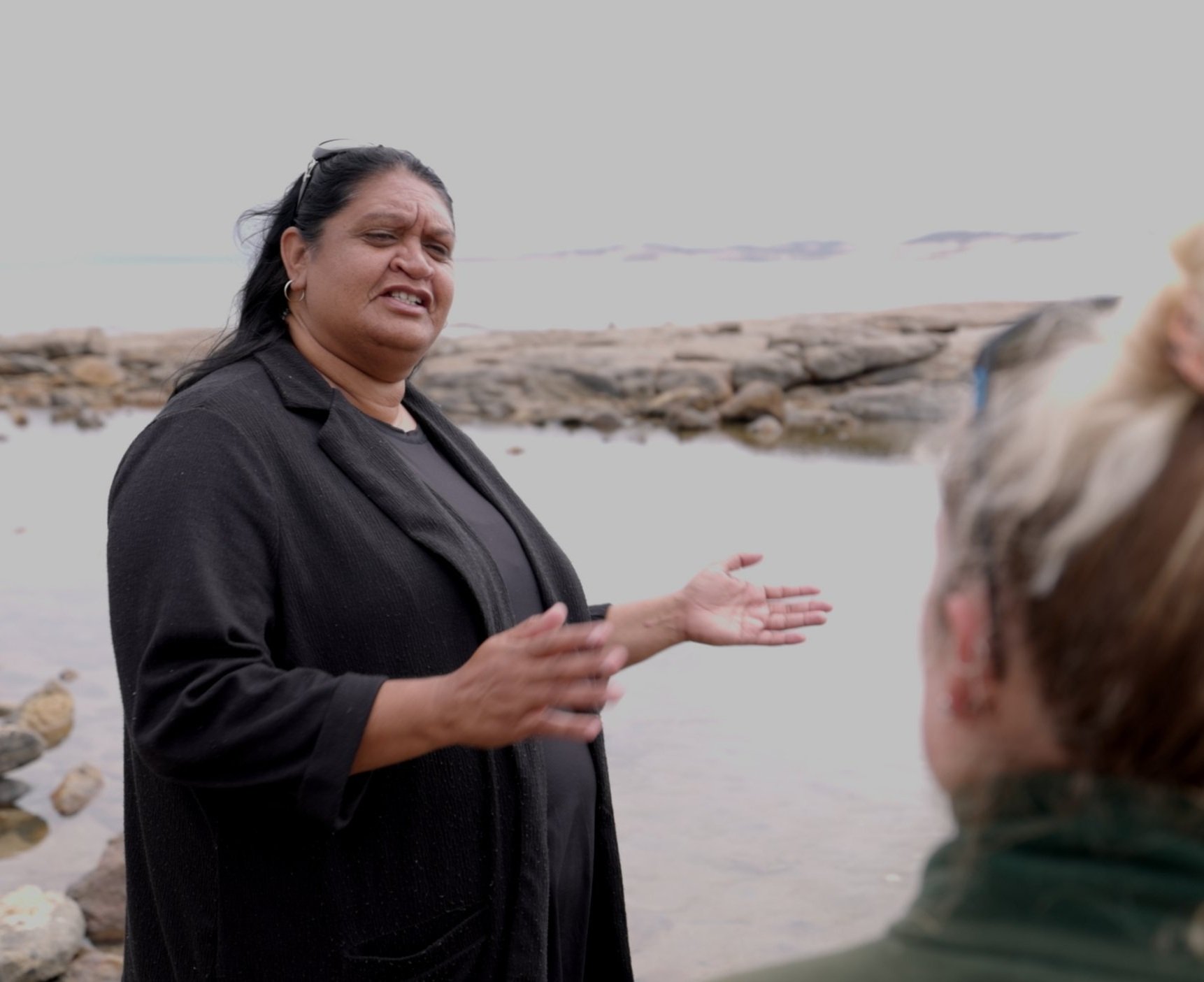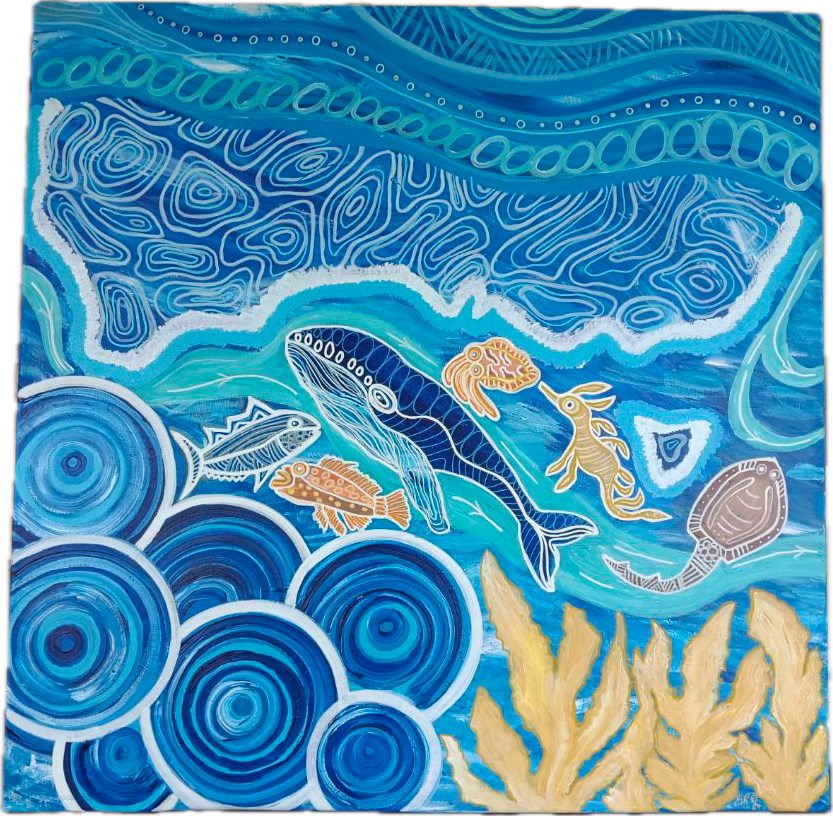Enriching Ocean Literacy with First Nations Insights
The underwater forests and coastal landscapes of the Great Southern Reef whisper ancient stories, carrying the wisdom of First Nations peoples. It's here, across Australia’s southern coastline, that educators find a unique opportunity to incorporate First Nations knowledge into their classrooms.
This article embarks on a journey to explore how teachers can enrich their curricula by integrating First Nations perspectives, with special insights from Emmalene Richards, a proud Barngarla woman from Port Lincoln.
By integrating these perspectives, educators can help bridge the gap between traditional ecological knowledge and contemporary environmental education, creating a richer, more inclusive curriculum that celebrates the diversity of Australia's cultural and natural heritage across the Great Southern Reef .
Caring For Country
For First Nations people, 'Country' encompasses not just the physical landscape but the spiritual and ancestral connections we have to the land and sea. Caring for Country, for First Nations peoples, embodies a profound and holistic approach to environmental stewardship that is deeply rooted in thousands of years of tradition and knowledge. This philosophy integrates sustainable practices, traditional ecological knowledge, and a deep respect for the natural cycles and balance of ecosystems.
Incorporating the concept of Caring for Country into educational settings offers a valuable perspective on sustainability and environmental ethics, encouraging students to see themselves as active participants in the preservation and nurturing of their surroundings. It invites a shift from viewing the environment as a resource to be used, towards seeing it as a community to which we belong and for which we bear responsibility. Richards elaborates, "Caring for Country is about understanding that we are part of the environment, not separate from it. It's about reciprocal care; as we look after the land and the sea, they look after us."
Richards encourages educators to create learning experiences that are not only informative but transformative, allowing students to engage with the concept of 'Country' in a way that fosters respect, understanding, and a sense of shared responsibility for its preservation. "It's about bringing the stories of the sea to life, making them relevant to today's challenges and inspiring the next generation to be caretakers of our marine heritage," she asserts.
“To have a connection to Country, means you belong somewhere.”
Engaging with Sea Country - Understanding and Respect
Emma Richards illuminates the profound significance of Sea Country to many First Nations communities, underscoring its role beyond mere geography. “Sea Country refers to the importance of the sea and highlights the spiritual connections to marine life and environment and everything that connects with the coastlines.” She stresses "The sea is not just a resource; it's a living entity that sustains and is sustained by our people."
This perspective invites a deeper understanding and respect for the sea, urging educators to weave these intrinsic values into their teaching, fostering a more profound connection and stewardship among students towards marine environments.
Richards is adamant about the urgency of this educational pivot, noting a gap in current teaching: "Generations are passing through our schools with scant knowledge of the traditional lands and waters they inhabit, particularly concerning Sea Country." Her message is clear and urgent: "The time for change is not tomorrow; it's today." This is a call for a transformation in how we view and teach about our interconnectedness with Australia’s oceans, urging a shift towards a deeper, more respectful engagement.
Suggested Resources:
Taking the first step
For teachers who are uncertain about where to begin in integrating First Nations perspectives, the journey starts with openness and a willingness to learn. Engaging with local First Nations communities, where possible, can provide invaluable insights and foster collaborative relationships.
Richards advises a starting point that roots in respect and acknowledgment: "Recognising the traditional custodians of the area of land and sea where your educational institution stands is a foundational gesture of respect. It's about seeking guidance and resources from the local traditional peoples First Nations organisations and cultural educators to ensure that what is shared is presented by the right people with traditional connections to land and sea and with authenticity and respect.
She further encourages educators to delve into the backgrounds and previous works of those they wish to collaborate with, stating, "A little research goes a long way. Understanding the history and achievements of your prospective partners can significantly enrich the collaboration, ensuring that the projects you undertake together are not just educational but transformative."
“Teachers need to seek advice, seek guidance. Once people take the first step and have a conversation, it’s really going to create a special journey - especially for the students to get a better understanding about the Sea Country that’s around them”
“We don’t know that people want to know unless they reach out and ask”
Relationship Building - Partners with Purpose
True understanding and integration of First Nations knowledge into education cannot be achieved without genuine relationships and partnerships with local First Nations communities. Emma Richards stresses the value of these connections, "Building relationships with local communities isn't just about enriching our programs; it's about acknowledging and respecting the custodianship they have maintained over these lands and waters."
Educators are encouraged to actively seek out opportunities for collaboration, whether through guest speakers, community-led projects, or visits to significant sites. By engaging in meaningful partnerships, schools can create a learning environment that respects and honours First Nations knowledge while contributing to the ongoing process of reconciliation and mutual understanding.
The essence of integrating First Nations knowledge into education lies in the genuine relationships forged with local communities. "It's through these connections," Emma reflects, "that we can truly understand the significance of what we're teaching and learning." For educators, this means reaching out, listening, and collaborating with First Nations peoples to bring authenticity and respect to their teaching.
Suggested Resource: Respectful Relationships
Communication and Effective Engagement
Emma Richards emphasises the significance of respectful and reciprocal communication. "Effective engagement is rooted in two-way listening. It's about entering a dialogue with openness to hear and learn, bringing an open heart and mind to the table, ready to be guided by the Aboriginal consultant you're collaborating with."
She underlines the importance of perseverance in fostering relationships, pointing out the potential loss for students if such efforts are neglected. "Cultivating relationships requires effort; it's not always straightforward. Sometimes it’s not easy but saying it’s too hard means it’s the kids that miss out and we need to put our kids first and foremost.”
Furthermore, Richards underscores the transformative potential of established relationships in fostering a conducive environment for deeper inquiries and enriched learning experiences. "Once relationships are built, they create a safe space to ask more questions and enhance the learning experience," she explains. Clarity in communication is also fundamental for meaningful engagement, with Richards emphasising the importance of clearly articulating the information sought. This preparation, she notes, enables the cultural educator to tailor the session effectively, ensuring the delivery of the most relevant and impactful knowledge to students.
Moreover, Richards advises on the necessity of ongoing communication throughout the engagement process. "Continuous dialogue ensures the alignment of objectives and the achievement of desired outcomes," she underscores. Such continuous engagement is essential for maintaining focus and ensuring that the educational experience is as fruitful and enriching as possible for all involved parties.
Suggested Resource: How will I establish a relationship with the Aboriginal and Torres Strait Islander educators that I will be working with?
Artistic Expressions
Art serves as a powerful conduit for education and cultural exchange, offering an immersive platform for engaging with and appreciating the stories, connections, and wisdom inherent in First Nations cultures. Emma Richards highlights the transformative impact of art in fostering a deeper understanding and respect for the heritage and ongoing contributions of traditional custodians.
Through creative expressions like murals, sculptures, and installations, cultural arts in public spaces communities can visualise the intricate relationship between First Nations peoples and their ancestral lands and seas. These artworks not only beautify spaces but also act as visual storytellers, carrying forward the legacy and essence of First Nations' deep-rooted connections to Country. Richards advocates for the integration of such art in educational settings, emphasising its potential to inspire curiosity, dialogue, and a shared sense of responsibility towards preserving and honouring these cultural narratives for future generations.
Suggested resource:
Aboriginal and Torres Strait Islander Art in the Classroom Volume 2. This publication suggests effective and meaningful ways to integrate Aboriginal and Torres Strait Islander histories and cultures into the daily life of any teaching and learning environment. With authentic links to the Australian Curriculum, including visual arts, history, music, performance, design and science, you will discover how works of art and artists can be the ideal platform or starting point to initiate conversations and learn about the world, its history, its people and protecting its future.
Case Study: Coastal Connections Program
A notable example of integrating First Nations perspectives into community engagement is the Coastal Connections program, led by National Parks and Wildlife Service SA Marine Coordinator Dr. Shelley Paull in partnership with Emma Richards, Experiencing Marine Sanctuaries and marine experts and part funded by the Eyre Peninsula Landscapes Board.
The two-day program combined traditional ecological knowledge with contemporary environmental education, offering participants activities such as snorkelling, birdwatching, kayaking, and cultural teachings. It was also a fully inclusive event, allowing people all of all abilities to participate and learn. Emphasising the concept of Caring for Country, the program encouraged participants to see the environment as a living community to which they belong.
Part of the SALT Festival, the festival also highlighted the vibrant marine life through artistic expressions like nudibranch lanterns, inspired by Shelley's iNaturalist photos, celebrating the cultural and ecological significance of marine ecosystems. This initiative has significantly deepened the Eyre Peninsula community's connection with their marine environment, fostering environmental stewardship and highlighting the importance of incorporating First Nations knowledge into education to inspire future generations to protect and preserve their marine heritage.
Initiating Change
Emma Richards' insights offer a strong foundation for educators seeking to enrich their classrooms with First Nations perspectives. By embracing concepts like Caring for Country and engaging with Sea Country, we embark on a journey of understanding, respect, and reciprocity.
Through meaningful partnerships, open dialogue, and a commitment to sustainability, we can create learning environments that honour the wisdom of traditional custodians and inspire the next generation of leaders to safeguard our Great Southern Reef. Indeed, as Emma reminds us, "It's about influencing change, and the people that are going to benefit from this are our children, our future leaders."
To support you on this journey, we've curated a selection of resources that further illuminate the paths you might take to integrate these essential perspectives into your classrooms.
Financial support from Department for Environment and Water and Parks Australia















